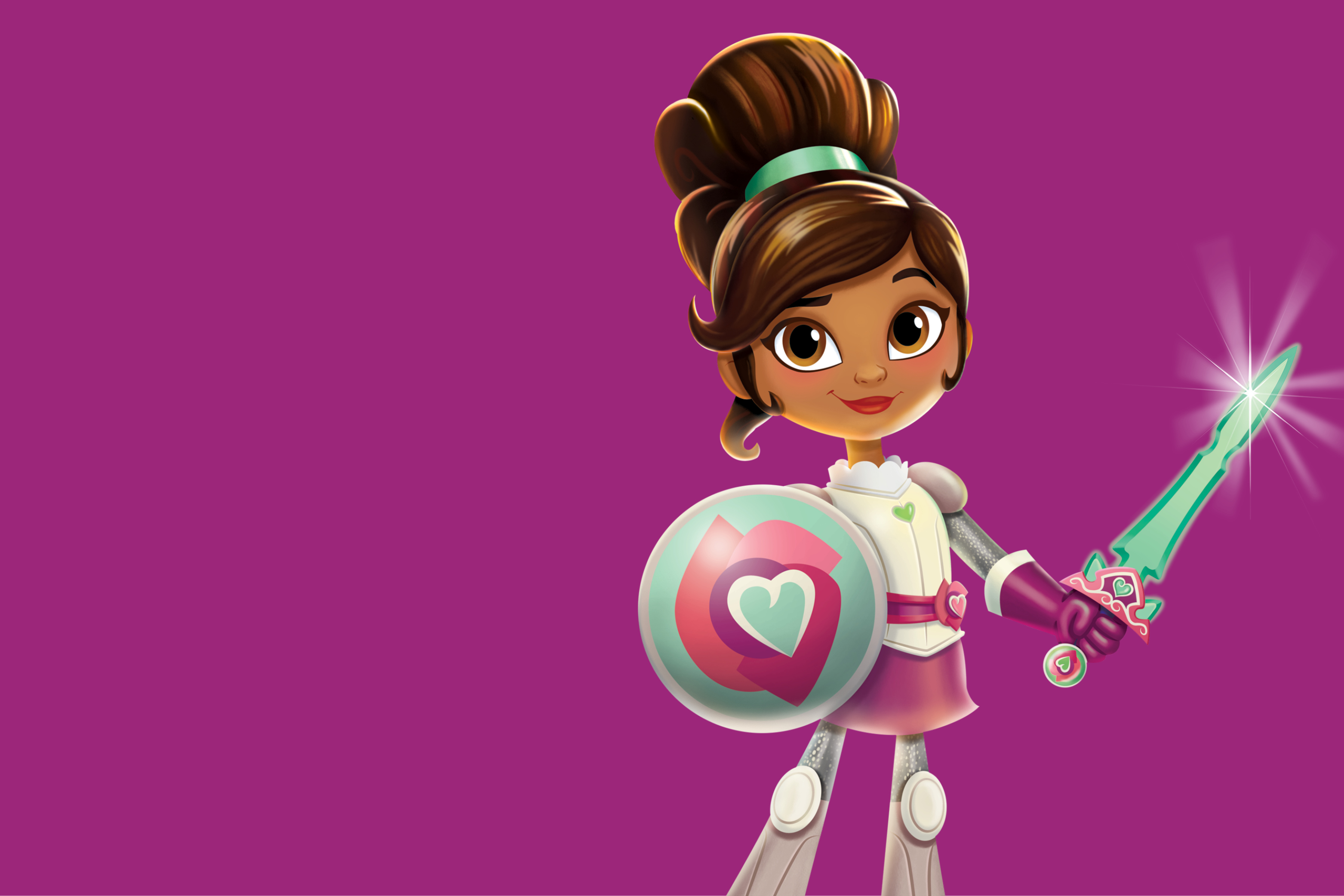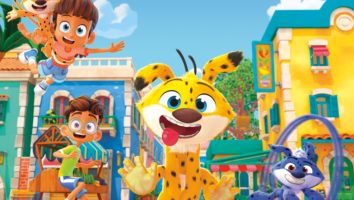As far as gender stereotypes go (and they seem to travel surprisingly far), girls have been traditionally depicted as sweet and nurturing creatures who gravitate toward quieter and more thoughtful play. The message seems to be: Leave the action and adventure to the boys. Well, it’s 2017, and a new crop of empowered preschool characters are changing perceptions about what it means to be a girl, right at the moment when their viewers’ identities are forming. These characters are also making their mark on the toy industry.
Nella, for one, carries a sword and is happily slashing through dated depictions. She is the star of Nickelodeon’s new animated preschool series Nella the Princess Knight, which follows the titular character as she embarks on daring quests to save her kingdom while promoting a social-emotional curriculum that concentrates on empowerment, inclusiveness and compassion for others.
According to Pam Kaufman, global chief marketing officer and president of consumer products at Nickelodeon, Nella embodies what it really means to be a little girl. She’s a princess who loves unicorns, and she’s also a knight who’s unafraid of adventure or physical challenges. Children have layers, Kaufman says, and Nella the Princess Knight is a representation of that.
Representation is crucial for kids, especially at the preschool age. “There’s so much research saying that gender stereotyping starts at an early age. Girls begin to view themselves, unfortunately, as less smart or talented. And this impacts their confidence,” notes Kaufman. “We believe the content we’re putting forward is really breaking down those barriers.”
According to recent research from the Geena Davis Institute on Gender in Media, 83% of film and TV narrators are male, and for decades, male characters have dominated nearly three-quarters of speaking parts in children’s entertainment. The female characters that do exist show dramatically more skin than their male counterparts and often display exaggerated body characteristics.
A new wave of female leads is working to end this trend. Like Nick’s Nella, Genius Brands’ Rainbow Rangers is focused on empowering girls. The action-adventure series for preschoolers was just picked up by Nickelodeon for Nick Jr. US and the Caribbean. It follows seven superheroes—Earth’s First Responders—as they protect the planet. Each character is inspired by a different color of the rainbow and possesses a unique personality and skill-set.
“Each color shows different strengths and vulnerabilities,” says Stone Newman, president of global consumer products and worldwide marketing for Genius Brands. “The show allows little girls to see that everybody gets an opportunity to shine.”

New toon Rainbow Rangers features seven female heroes with unique strengths to show girls it’s OK to be different
Breaking up the boys club
Sarah Chumsky, VP of Insight Kids at research firm Insight Strategy, says these messages have the biggest impact on kids in their preschool years.
“Kids are just developing their sense of gender identity in preschool, and media can play a really strong role in reinforcing stereotypes or reinforcing the possibilities,” says Chumsky. “Because these stories are so engaging for kids, and these characters are so relatable and aspirational, there’s a big responsibility in how you portray boys and girls in your work.”
And the portrayal doesn’t stop on the screen. Tara Hefter, VP of global licensing for L.A.-based toyco Jakks Pacific, says companies are capitalizing on the trend of strong female characters in consumer products.
“We’re seeing different shows where female characters are empowered to wield swords and shields,” Hefter says. “It’s not just about fighting; it’s showing that they can be just as strong and courageous as male characters.”
As a result, she says, items that have traditionally been associated with boys—such as role-play products and weapons—are now much more likely to be released in association with girl-skewing properties. Nella the Princess Knight has a sword, and the titular heroine in Disney’s Elena of Avalor carries a magical scepter. Kaufman agrees, saying that categories like construction and gaming are also seeing more and more entrants from girl-centric shows.
This issue of merchandising is also being reexamined in the wake of so many strong female leads, according to Hefter.
“It’s becoming a bigger question as to how to merchandise,” she says. “I think there’s more of an impression that aisles are becoming gender neutral, because if I put this product in the boys aisle, I could turn away girls. And if I put it in the girls aisle, I could turn away boys. Companies are wondering how they can take a character that appeals to both boys and girls and place it so that everyone can buy into it.”

Saban’s marketing shows girls playing with the full line of Power Rangers toys, not just the pink ones
Breaking down walls and crossing aisles
An aisle that is not defined by gender, Hefter says, automatically becomes an aisle filled with toys that are no longer defined by gender. This invites half the consumer population previously ignored by strict boy/girl merchandising to engage with the product.
Following Disney’s 2012 film Brave, Hefter says there was debate about whether or not girls would want a bow and arrow set based on the main character’s weapon of choice. But she says the bow and arrow quickly became a top-selling item and had to be triple-tooled to meet demand. Jakks continues to feature opportunities for empowered dress-up play with products like Elsa’s ice scepter (Frozen) and Wonder Woman‘s action purse.
Similarly, Nella the Princess Knight presents a number of opportunities for empowering role play with a focus on swords and suits of armor. UK-based Vivid Group has been named global master toy licensee for the series (excluding the US), and categories covered in the deal include dolls, playsets, plush and role-play toys set to launch in spring 2018. Another of Nick’s girl-focused preschool shows—Shimmer and Shine—launched its inaugural consumer products line in July.
Shimmer and Shine follows twin genies-in-training who grant wishes for their best friend. The property’s games and puzzles capitalize on the show’s focus on teamwork and resilience in overcoming obstacles, while toys and role-play items center around flying carpets and the main characters’ magical abilities.
“It’s always been very important to me that our female lead characters solve the problems,” says Farnaz Esnaashari-Charmatz, creator and producer of Shimmer and Shine. “They are their own heroes. They don’t need the boy characters to do it for them, but they all work and have fun together.”
And because the characters embody teamwork and resilience, so do the products, notes Esnaashari-Charmatz. “The extension of the merchandise and toy world really just allows the kids to be part of this imaginary world in real life, and act out and play as those characters would,” she says.
Genius Brands’ Newman believes girls will also identify with the personalities of the heroes in Rainbow Rangers. Mattel’s Fisher-Price has signed on as the property’s worldwide master toy partner, and Newman says the toys based on each character will showcase their unique personality and strengths. He believes the consumer products program will inspire girls to identify with superheroes in the same way traditional action figures have for boys.
“Female empowerment is not new,” Newman says. “But when we started putting this show together, we saw this void in the marketplace for an action-based adventure series for little girls. We wanted to start that conversation and positive messaging with girls at a younger age.”
In contrast, Tori Cook, SVP of global retail business development at Saban Brands, believes marketing and advertising specifically to boys or girls will soon be a thing of the past. Saban, she notes, has featured female characters in action-hero roles since its flagship Power Rangers brand debuted in 1993.
“I think there’s a movement towards just creating great products and not saying they’re for girls or they’re for boys, and just letting the kids naturally choose which toys and products appeal to them the most,” says Cook. “Aisles can act as walls or barriers to following through with a strong message about gender-inclusiveness and how kids play together. I do see positive changes in the ways that merchandising is being approached.”
In its merchandising and advertising with Target this year, Saban featured boys and girls playing with products associated with each Ranger, from red to blue to pink.
Insight Strategy’s Chumsky agrees that including boys and girls in advertising and packaging is the simplest solution, as it immediately invites every kid to see themselves as belonging to the world the characters inhabit.
Because the message of empowerment that sits at the heart of shows like Nella the Princess Knight, Shimmer and Shine and Rainbow Rangers extends into those properties’ consumer products programs, it means kids are engaging with these themes in different ways throughout their day. And this makes it even more imperative that the message be clear, Chumsky says.
“One thing that I think about in terms of this ‘girl power media’ is that when those messages are really overt, what you’re subconsciously teaching kids is that people think girls are inferior and need extra encouragement in order to be equal. I’m disappointed by how didactic these things can be,” she says.
“Just showing girls doing it, just showing girls and boys on equal footing, showing girls being leaders, showing girls sometimes being villains and sometimes being heroes—that is a more productive way to implicitly teach girls and boys they can do anything they want to do and be anything they want to be.”
Gary Pope, director of London-based research and marketing agency Kids Industries, agrees that giving girl characters traditionally masculine traits is a “simplistic” approach to empowerment. He also sees the trend of female superheroes as misguided, as it’s portraying empowerment as attached to fantastic physical ability.
“That’s a bit crap, really, because kids can’t do that,” he says of saving the world through the use of superpowers. Pope would rather focus on traits with which all kids can identify.
“If we’re talking about preschoolers, we’re looking at Peppa Pig,” he says of Entertainment One’s billion-dollar preschool brand. “There are just as many boys as girls who engage with Peppa. Why is that? She’s incredibly straightforward, and that’s not really a feminine or masculine trait, that’s just childlike. And that works really well. Strong female characters are great for a brand’s PR, and I worry sometimes that they might be more about lip service,” says Pope.
Breaking free and looking forward
The focus should be on good stories with complex characters, Pope contends. But he admits that the reality of the industry—and society at large—means that special attention needs to be paid to creating characters that help children understand themselves and how they should maneuver through the world.
“You’ve got to see it to be it, as a child,” he says. “If you want to grow from your engagement with entertainment and your understanding of the characters, then there have to be patterns within that character’s development and their own narrative which are reflective of you or that you can aspire to in some way.”
Jakks’s Hefter agrees that the recent wave of strong female leads is heavy on the heroes, but because the genre has been so defined by male characters in the past, she thinks it is a step in the right direction.
“We’re seeing strength,” Hefter says. “Not only physical strength, but also strength expressed through things like determination and independence. We’re seeing girl characters who are courageous and creative. It’s important because this is what young girls are seeing, and it does define their world.”
Hefter stresses it also defines the world of boys. “I think that boys seeing these strong characters might be more important than girls seeing them. I think a big piece of this is having boys embrace and accept girls as equals,” she posits. “Boys responding to these empowered female leads could be more of a game-changer than the girls reacting to them, because I don’t think young girls are limiting themselves. Little girls are limited by society.”
Boys and girls engaging with these characters through entertainment and consumer products will help them shape their identities and the way they see each other, Hefter adds. If the trend continues, she believes the road to gender revolution could be, in part, paved with toys.
Sunny Day takes up the empowerment torch
Like Shimmer and Shine and Nella the Princess Knight before it, Nickelodeon’s upcoming animated preschool series Sunny Day is all about empowerment. The show follows 10-year-old hairstylist and entrepreneur Sunny as she solves problems in her seaside town Friendly Falls with creativity and determination. The show’s social-emotional curriculum highlights leadership skills and teamwork, while the characters were designed to celebrate individuality and self-expression. The 20 x 22-minute series is produced by Silvergate Media (Peter Rabbit) and will debut in the US in August. Consumer products inspired by the show will begin rolling out in 2018.


























